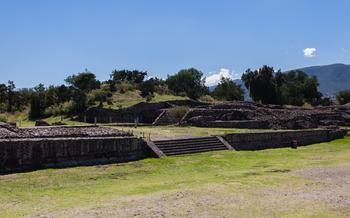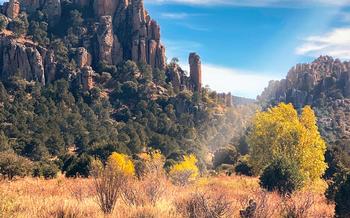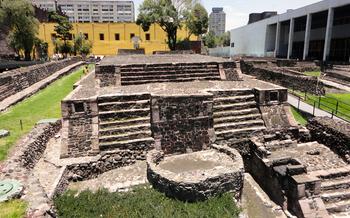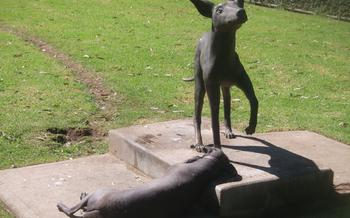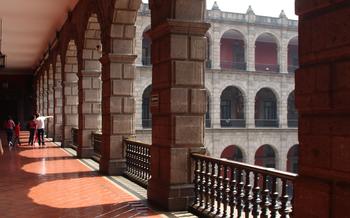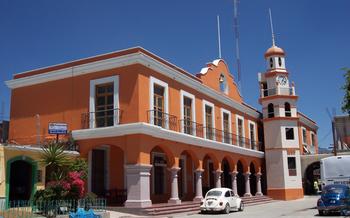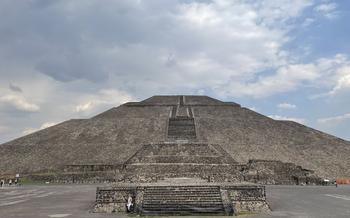
La Quemada Ruins
- La Quemada Ruins: A Majestic Symbol of Mexico's Ancient Past
- Location: A Journey to the Heart of Zacatecas
- Historical Background: Unraveling the Secrets of the Past
- The Observatory: A Window to the Cosmos
- The Museum: Unveiling the Past through Artifacts
- The Legends and Myths: A Tapestry of Folklore
- The Festivals and Events: A Celebration of Culture
- The Natural Surroundings: A Desert Oasis
- The People and Community: Guardians of Heritage
- What to Pack: Essentials for a Desert Adventure
- Safety Tips: Ensuring a Safe and Enjoyable Experience
- Responsible Tourism: Protecting the Legacy
- Insider Tip: Discovering Hidden Gems
La Quemada Ruins: A Majestic Symbol of Mexico's Ancient Past
Journey into the heart of Mexico's rich history at the La Quemada ruins, an awe-inspiring archaeological site nestled within the state of Zacatecas. Dating back to around 1000 AD, these pre-Columbian ruins stand as a testament to the ingenuity and architectural prowess of ancient civilizations. Explore the impressive structures, including the Great Platform, the Temple of the Columns, and the Ball Court, marvels of engineering that showcase the advanced skills of these ancient builders. Discover the cultural significance of this ancient city, where rituals and ceremonies once took place, and immerse yourself in the daily lives of its inhabitants through captivating stories and historical accounts. As you wander through the ruins, appreciate the ongoing preservation efforts dedicated to protecting this valuable historical site for future generations, ensuring its legacy endures for years to come.
Location: A Journey to the Heart of Zacatecas
The La Quemada ruins are situated in the heart of Zacatecas, a state in central Mexico known for its rich history, stunning landscapes, and cultural traditions. The site is conveniently located near the city of Zacatecas, the state capital, which serves as a major transportation hub with an international airport and well-connected bus routes. From Zacatecas, visitors can easily embark on a day trip to the La Quemada ruins, which is approximately 50 kilometers (31 miles) south of the city.
To reach the ruins, visitors can choose from various transportation options. Driving is a popular option, as the roads are well-maintained and offer scenic views of the surrounding countryside. Rental cars are available at the Zacatecas airport or in the city center. Alternatively, visitors can opt for a more relaxed and informative experience by booking a guided tour. Several tour operators offer day trips from Zacatecas, providing transportation, guided exploration of the ruins, and insights into the site's history and significance.
In addition to the La Quemada ruins, Zacatecas offers a wealth of other attractions for visitors to explore. The city of Zacatecas itself is a UNESCO World Heritage Site, renowned for its colonial architecture, narrow cobblestone streets, and stunning views from El Cerro de la Bufa, a hilltop park overlooking the city. Other nearby attractions include the Cerro de los Remedios, a pilgrimage site with a large statue of Christ, and the Sierra de Órganos National Park, known for its unique rock formations.
When planning your visit to the La Quemada ruins, consider staying in Zacatecas to fully immerse yourself in the region's cultural and historical offerings. The city offers a range of accommodation options, from budget-friendly hostels to luxurious hotels, catering to different preferences and budgets. Zacatecas is also renowned for its culinary delights, with traditional Mexican restaurants serving mouthwatering dishes such as enchiladas, pozole, and birria.
Historical Background: Unraveling the Secrets of the Past
The La Quemada ruins, dating back to the pre-Columbian era around 1000 AD, hold a rich and intriguing history. Constructed by the Zacatecos tribe, the site flourished as one of the region's most important cities during the Mesoamerican period. Over time, it experienced diverse cultural influences, including those of the Teotihuacan, Chalchihuites, and Caxcan cultures, each leaving its unique imprint on the city's development.
Archaeological excavations and discoveries have shed light on the purpose and significance of the La Quemada ruins. While its exact function remains debated, theories suggest it served as a ceremonial center, a military stronghold, or a trading hub. The site's strategic location along trade routes and its impressive fortifications support these hypotheses.
Various controversies and mysteries surround the La Quemada ruins. The reason for its abandonment remains unclear, with theories ranging from warfare and climate change to religious shifts. Additionally, the identity of its builders and their connection to other ancient civilizations continue to fuel scholarly debates. These enigmas add to the allure of the site, inviting visitors to delve deeper into the captivating history of this ancient city.
The Observatory: A Window to the Cosmos
The La Quemada ruins hold a fascinating astronomical significance, revealing the ancient inhabitants' advanced knowledge of astronomy and mathematics. The site's structures are meticulously aligned with celestial events, such as solstices, equinoxes, and lunar cycles, suggesting its use as an observatory. Discover the unique alignments of the Great Platform, the Temple of the Columns, and other structures that track the movements of the sun, moon, and stars. Explore how these alignments influenced the daily lives, rituals, and beliefs of the ancient civilizations who built this remarkable site. Immerse yourself in the mysteries of the cosmos as you uncover the astronomical wonders of the La Quemada ruins.
The Museum: Unveiling the Past through Artifacts
In the heart of the La Quemada ruins, visitors can delve into the history and culture of the ancient inhabitants at the on-site museum. This treasure trove of artifacts, pottery, tools, and other objects found during archaeological excavations offers a glimpse into their daily lives, customs, and traditions. Through interactive exhibits, visitors can explore the significance of these artifacts, gaining a deeper understanding of the society that flourished here centuries ago. Guided tours led by knowledgeable experts provide an even more immersive experience, bringing the past to life and shedding light on the mysteries of this ancient city.
The Legends and Myths: A Tapestry of Folklore
The La Quemada ruins are not merely a collection of ancient structures; they are also a repository of fascinating legends and myths that have been passed down through generations by the local communities. One of the most popular legends is that of the fire serpent, a mythical creature said to be associated with the site and its origins. According to the legend, the fire serpent emerged from the depths of the earth and demanded sacrifices from the people. Those who refused to comply were met with fiery destruction, while those who offered their offerings were granted protection and prosperity.
This legend reflects the deep-rooted beliefs and fears of the ancient inhabitants of the La Quemada ruins. It speaks to their awe of the natural world and their attempts to appease powerful forces beyond their control. The legend of the fire serpent adds a mystical element to the history of the site, making it even more intriguing and captivating for visitors.
These legends and myths are not just mere stories; they are an integral part of the cultural heritage of the region. They provide insights into the beliefs, fears, and aspirations of the ancient people who lived there. By exploring these legends and myths, visitors can gain a deeper understanding of the rich cultural tapestry that surrounds the La Quemada ruins.
The Festivals and Events: A Celebration of Culture
In the vicinity of the La Quemada ruins, the spirit of the region comes alive through vibrant local festivals and events that showcase the rich cultural traditions of the area. These celebrations offer a unique opportunity to immerse oneself in the local way of life and witness the passionate expressions of cultural heritage.
During these festivals, traditional dances and performances take center stage, bringing to life the history and stories of the region. The air fills with the rhythm of music, the colors of elaborate costumes, and the infectious energy of the performers. Visitors can witness traditional dances such as the Matachines, performed by elaborately dressed dancers, or the Danza de los Viejitos, a humorous dance that portrays elderly characters.
Beyond dance, these festivals also showcase local music, crafts, and culinary delights. Visitors can savor the flavors of traditional dishes, admire the intricate designs of handmade crafts, and experience the warmth and hospitality of the local communities.
Participation in these festivals is not limited to spectators; visitors are encouraged to join in the festivities, immersing themselves in the local culture and creating lasting memories. The festivals foster a sense of belonging and cultural pride among the local people while providing visitors with a glimpse into the vibrant cultural tapestry of the region.
The Natural Surroundings: A Desert Oasis
The La Quemada ruins are immersed in a captivating natural setting, featuring a distinctive arid and semi-arid landscape. The desert terrain showcases diverse vegetation, including cacti and unique rock formations, creating a picturesque backdrop for exploring this ancient site. Visitors can embark on hiking trails that wind through the desert, offering panoramic views and opportunities for nature enthusiasts to discover the diverse wildlife that inhabits the area, including various bird species, reptiles, and small mammals. The La Quemada ruins serve as a reminder of the intricate relationship between ancient civilizations and their natural surroundings, showcasing the remarkable adaptations of both flora and fauna to thrive in this challenging environment.
The People and Community: Guardians of Heritage
In the vicinity of the La Quemada ruins, you will encounter the welcoming and proud local communities who are the custodians of their rich cultural heritage. These communities have deep roots in the region, and their traditions and customs have been passed down through generations. Engaging with the locals offers a unique opportunity to gain insights into their way of life and their connection to the ancient past.
The indigenous heritage of the region is a source of pride for the local communities. They actively work to preserve and promote their cultural traditions, ensuring that their legacy continues to thrive. Visitors are encouraged to learn about and respect these traditions, fostering a sense of cultural exchange and understanding.
Sustainable tourism is a priority for the local communities. They recognize the importance of balancing the preservation of their cultural heritage with the development of tourism. By supporting local businesses and initiatives that promote sustainable practices, visitors can contribute to the well-being of the communities and ensure that the La Quemada ruins remain a source of inspiration for future generations.
What to Pack: Essentials for a Desert Adventure
Packing for a visit to the La Quemada ruins requires careful consideration of the desert environment. Start with comfortable and breathable clothing suitable for warm weather. Sun protection is crucial, so pack sunscreen, sunglasses, and a hat to shield yourself from the intense desert sun.
Stay hydrated and energized with plenty of water and snacks. Sturdy footwear, such as hiking boots or comfortable shoes, is essential for navigating uneven terrain. Don't forget your camera to capture the stunning scenery, and binoculars for wildlife spotting. Remember, responsible packing helps protect the fragile desert ecosystem.
Safety Tips: Ensuring a Safe and Enjoyable Experience
Visiting the La Quemada ruins should be a safe and enjoyable experience for all. Here are some safety tips to keep in mind:
-
General Safety: Familiarize yourself with general safety tips for traveling in Mexico, such as being aware of your surroundings, avoiding isolated areas at night, and keeping your valuables secure.
-
Desert Safety: Be aware of specific safety measures for visiting desert regions. Stay hydrated by drinking plenty of water, avoid wildlife encounters by maintaining a safe distance, and be prepared for extreme weather conditions by checking the forecast and dressing appropriately.
-
Guided Tours: Consider joining a guided tour for added safety and peace of mind. Guides are knowledgeable about the area and can provide assistance if needed, such as navigating the terrain, identifying wildlife, or explaining historical and cultural aspects of the site.
-
Respecting the Site: Remember that the La Quemada ruins are a historical and archaeological site. Be respectful by avoiding touching or damaging any structures or artifacts. Stay on designated trails to prevent erosion and preserve the integrity of the site for future generations.
Responsible Tourism: Protecting the Legacy
As a responsible traveler, it is crucial to understand the importance of sustainable tourism when visiting the La Quemada ruins. Minimize your environmental impact by reducing waste, respecting wildlife, and following designated trails. Support local businesses and initiatives that promote sustainable tourism and benefit the local communities. By doing so, you contribute to the preservation of this valuable historical site and ensure that future generations can continue to appreciate its cultural and archaeological significance. Additionally, be culturally sensitive and respectful of local customs and traditions, ensuring your interactions with the community are positive and meaningful.
Insider Tip: Discovering Hidden Gems
Beyond the well-known structures and attractions of the La Quemada ruins, there are hidden gems waiting to be discovered by curious travelers. Venture off the beaten path to explore secluded spots that offer unique perspectives and opportunities for exploration. Discover lesser-known areas within the site where you can enjoy breathtaking views, encounter wildlife in their natural habitat, or simply find a tranquil spot to soak in the atmosphere of this ancient city. Ask locals or tour guides for recommendations on hidden gems and off-the-beaten-path experiences that may not be commonly known to tourists. Explore the surrounding area beyond the La Quemada ruins to discover other historical sites, natural wonders, or charming towns that offer a rich cultural experience.
